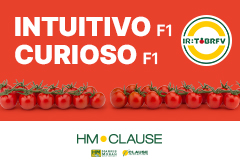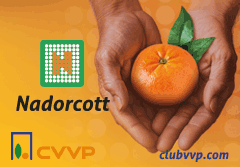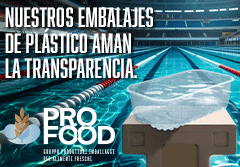Spain is the 7th producer worldwide of bio fruit and vegetables and it has a very positive future ahead if it manages to overcome some of its shortcomings
In 2016, the Spanish ecological sector continued with the consolidation and development process observed in previous years, and the surface area registered exceeded, for the first time ever, the barrier of 2 million hectares (+2.55% compared to 2015), according to data from MAPAMA. Year after year, the sector increases its commitment to this sustainable, environmentally-friendly cultivation system, carried along by the growing demand in the world, and fruit and vegetables continue to be one of the five main lines of products, both in volume and in value. Specifically, the group of vegetables and root vegetables was the one that grew the most in volume with +34,52% compared to 2015, reaching 294,590 tonnes and 282.81 million euros (16.56% of the total value at source). Strawberries were also on the rise, with a production increase of 32.25%, along with citrus fruits, with +7.27%.
Within this context, Andalusia continues to be the leader in ecological production, not only nationally, but also on a European level, both in surface area (976,413.94 hectares, of which 8,576.76 are exclusively for vegetables) and in the number of operators (14,489 – most of which, 10,908, are agricultural operators), although in 2016 the surface area decreased, dropping below the emblematic one million hectares. A drop caused by the Public Administration removing two protected natural spaces (the Natural Park of Cazorla, Segura and Las Villas, and the Natural Space of Doñana) from the list previously certified as ecological surface area for livestock development between 2016 and the beginning of 2017, the chairman of CAAE, Álvaro Barrera, explained to Fruit Today. In spite of everything, Andalusia makes up 42% of the state surface area and “other communities are starting to take on relatively greater importance; to a large extent, because their regional governments have granted aid to producers in 2016-2017. Therefore, Murcia has grown by 35%, Catalonia by 18% and Navarre by 13%…”
Concentrating on the segment we are concerned with, that of fresh fruit and vegetables, it is worth mentioning the good progress of crops under plastic cover, which have “doubled the eco surface area in just one year”. Producers are seeking greater profitability through this type of crops, with prices in some cases that are much higher than those for the same produce when grown conventionally. For example, according to data collected during the last quarter of 2016 and the first quarter of 2017 by MAPAMA, red peppers represented a conventional-eco price differential of 251.4% at the point of sale (1.39€/kg compared to 3.38€/kg); Canary/pear tomatoes, of 143%; and others with less volume, such as carrots, of 434.4%.
However, not everything in this garden is rosy. In recent years, the proliferation of new companies that are joining this sector, both small and medium-sized, and combined giants (conventional and ecological) that move considerable volumes, is causing a destabilisation in the sector. Produce accumulates at certain times of the campaign, causing a drop in prices; specialised companies complain of “distortions” in the market and important price fluctuations in a segment that was previously more stable; and there also have been cases where some operators “are not doing things the way they should be done.” In view of all this, many producers are asking the Administration for more controls.
Ecological vegetable production at source (in thousand tonnes)
| 2016 | Variation compared to 2105 | |
| Vegetables and root vegetables | 294.59 | + 34.52% |
| Citrus fruits | 142.42 | + 7.27% |
| Fresh fruit (without citrus or strawberries) | 72.29 | -9.85% |
| Strawberries | 5.08 | +32.25% |
Lack of structuring
The sector, which was already fragmented, currently has in Spain 36,253 eco agricultural producers and 2,810 industrial companies, and it “lacks authentic representation, dialogue and structuring instruments or systems, which are valid and efficient for the sector as a whole,” according to MAPAMA. Would the creation of an Interprofessional Agrifood Organisation (IAO) for Spanish ecological production be a good idea? According to a study by MAPAMA, without any doubt, although in the short term this would not seem feasible. Perhaps we should look at organisations from other countries which, although they do not follow the structure of IAOs, they have instruments that are “efficiently and powerfully structured,” such as the Agence BIO in France or BÖLW in Germany.
2% internal consumption in 2020?
One of the milestones to emphasise in the analysis of the Spanish Ecological Production Sector in 2016 is the important growth process of internal consumption, which reached 1,685.5 million euros (+12.51%), and was much higher than that experienced by the overall and general consumption of food and drink in Spain in 2016 compared to 2015 (0.7% in the overall Spanish food consumption as a whole), as detailed by MAPAMA.
Eco products already represent 1.69% of the total shopping basket, with an annual cost expenditure of 36.33 euros (+68.9% compared with 2012), and over 64% of the ecological products that we buy belong to six product lines, the most important one of them being that of vegetables, potatoes and derivatives (18.5%). With this information, the Ministry ventures that “before 2020 the home market could pass the 2% barrier of total consumption.”
Outside our borders, world consumption is rising at a much faster rate, going from 11,500 million euros in 2011 to over 88,000 million in 2016. And analysts estimate that the growth curve will be maintained in the years to come, taking over a larger share on the traditional markets and adding new emerging markets; therefore, on the 2025/2026 horizon, the ecological market could mean up to 175,000 million euros. In the EU alone, one of the most traditional markets of ecological produce, the value rises to 30,000 million (without forgetting its production weight with 12,000,000 Hectares and 270,000 ecological farms). On the podium of largest ‘green’ consumers are Switzerland (which increased bio consumption by 47.69% between 2012 and 2015), Denmark and Sweden (88.30%).
With these figures, the chairman of the CAAE has no doubt that the future of ecological fruit and vegetable producers in Spain is shaping up to be “really positive. Our home market is getting larger and larger and the foreign market is growing in leaps and bounds, which encourages exports.” An efficient strategy for positioning our products is “to concentrate on the production of varieties which, due to our weather conditions, can be harvested before they can in other countries. And at the same time, an effort must be made to ensure that consumers make a decisive commitment to national produce when offered alongside foreign products. In countries such as Switzerland, for example, when there is any home-produced vegetable on the market, the consumers opt for this one as opposed to others from abroad, even when the price is appreciably cheaper.”
ECO sales channels (% of share in volume: total food / fresh food)
| Total food | Fresh food | |
| Hypermarkets | 13.3% | 8.0% |
| Supermarkets | 45.1% | 33.3% |
| Discount supermarkets | 15.9% | 10.3% |
| Traditional and specialised stores | 15.6% | 33.8% |
| Other channels | 9.0% | 14.2% |
| e-commerce | 1.1% | 0.4% |
Export strength
The high level of internationalisation is one of the main values of Spanish ecological production. Last year, foreign sales grew by 14.5% and reached a figure of around 891 million euros as a whole (25.5% were vegetables, potatoes and pulses). If we take the year 2011 as a reference point, the growth curve is even greater, with +73.14%. In addition, Spanish eco exports made up 5.62% of the total eco sales on a worldwide scale in 2016. The specialisation of the sector is one of the keys to this positive evolution that puts it in the first places of several rankings within this category. As a sample, consider these figures from MAPAMA:
- It is the 4th largest worldwide exporter of ecological produce (6.2% of world exports, only behind the USA, Italy and the Netherlands).
- It holds the 4th position regarding availability of registered ecological surface area (around 3.9% worldwide) and the 3rd with most surface area of crops devoted to eco production (7.8% as opposed to 1.1% on average worldwide).
- It is the 4th country within the large ecological producers, according to number of ecological agricultural producers (only behind Mexico, Turkey and Italy).
And breaking it down by products:
- Spain holds the 2nd place worldwide for its ecological citrus fruit production capacity, only behind Italy (in 2016 it could have exceeded 15% of the total ecological surface area devoted to this crop).
- It holds the 7th position worldwide for production capacity of fresh ecological vegetables, with a surface area that in 2015 represented 3.80% of the entire worldwide extension of eco vegetables.
- It is 10th in the ranking of producing countries of temperate climate fruit (apples, pears, plums, peaches, cherries, etc). In 2015 it represented 1.66% of the total ecological surface area worldwide devoted to this crop.
- In 2015, it rose to the 15th position worldwide in the production of ecological tropical and subtropical fruit with a surface area of nearly 1% worldwide.
Main exporters of ecological products in 2015 (million euros)
- U.S.A.: 2,409
- Italy: 1,650
- Netherlands: 928
- Vietnam: 817
- SPAIN: 778
- Source: FIBL/IFOAM
New legislation
The Spanish Standardisation Association (UNE) has passed three new input standards for ecological farming in order to bring the fertilizer and plant protection products in the eco sector into line: UNE 142500, on fertilising products, amendments and growing media; UNE 315500, on products for pest and vegetable disease management; and UNE 66500. The launch of these texts, developed by work groups promoted by MAPAMA with the participation and consensus of organisations from the sector such as the CAAE, is “a complete success,” the chairman of CAAE, Álvaro Barrera states. “Regulating all the aspects linked to the supplies implies coherence and guarantees in the face of the entire ecological production process of a product, since any irregularity related to the use of fertilisers or plant protection products used on a farm could derive in serious damages for the farmer. Additionally, all the guarantees attached to the production system are also translated into guarantees for the end consumers and obviously, in advantages for the national supplies producers, as these standards will be able to show the international market their extra added value which, without any doubt will open up many doors for them.”
CAAE already certifies eco products from third countries
CAAE, the certifying organisation is a leader in Europe. It has the largest number of operators and surface area in ecological produce, easily exceeding a million certified hectares, almost 60,000 of fruit and vegetables. Since last May, they have been working from their headquarters in Lima (Peru), and recently the European Commission authorised the company to apply their certification standard to ecological products that reach Europe from third countries. This step will allow them to continue moving forward towards their goal of becoming a worldwide reference, particularly in Spanish-speaking countries, and on other emerging markets such as Asia. This authorisation has been “received enthusiastically” by the certifying company, which now can “apply the CAAE standard in third countries, which is translated into the fact that products certified by CAAE in Bolivia, Ecuador, Mexico, Morocco, Peru and Turkey will reach Europe with the EU stamp,” states the chairman of CAAE, Álvaro Barrera.
























